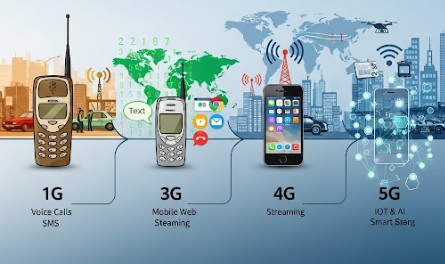
Think about the first mobile phones. They were big and could only make phone calls. Fast forward to today, and we have phones that can do almost anything, from watching movies in HD to talking to someone on the other side of the world with a video call. This amazing change is all thanks to the different generations of mobile internet. Let’s take a simple look at how our internet has changed from 1G to the super-fast 5G we have today.
1G: The Start of Mobile Calls
The very first generation, 1G, came out in the 1980s. Its main purpose was not for the internet at all. It was for mobile voice calls only. The signal was analog, which meant it was not very clear and could sometimes be a bit fuzzy. There was no such thing as downloading or Browse the internet on a 1G phone.
2G: The First Text Messages
In the 1990s, we got 2G. This was a big change because it used a digital signal. This made phone calls much clearer. The most important thing about 2G was that it allowed us to send text messages (SMS) for the first time. It also offered a very basic, very slow internet. Downloading something small might take several minutes, with speeds of about 9.6 to 40 Kbps (kilobits per second). This was enough for simple emails and very basic web pages.
3G: The First True Mobile Internet
The 2000s brought us 3G, and this is when the mobile internet we know today really started. With 3G, you could finally browse the internet properly on your phone, send emails with photos, and even make simple video calls. The download speeds were a lot faster, with typical speeds ranging from 1 to 2 Mbps (megabits per second). This made the internet a real part of our phones for the first time.
4G: The High-Speed Internet You Know Today
Around 2010, 4G arrived and changed everything. It gave us the high-speed mobile internet we use every day. With 4G, you can easily watch HD videos without buffering, download songs in seconds, and play online games without much lag. The typical download speeds for 4G are between 15 to 40 Mbps, but they can be much faster depending on your network and location. This is the internet that made smartphones truly “smart.”
5G: The Future is Ultra-Fast
5G is the latest and most powerful generation of mobile internet. It is not just a little faster than 4G; it is a giant leap forward. With 5G, you can get typical download speeds of 100 Mbps to over 900 Mbps, and in some cases, even faster. This allows you to download an entire movie in just a few seconds!
5G vs. 4G: Speed and Big New Features
While 4G is fast, 5G is on another level. Here’s a simple comparison:
| Feature | 4G | 5G |
|---|---|---|
| Typical Speed | 15-40 Mbps | 100-900+ Mbps |
| Download Time | A song in seconds, a movie in minutes | A song in a flash, a movie in seconds |
| Lag (Latency) | A little bit of lag (e.g., in online games) | Almost no lag, very instant |
| Connections | Good for many phones in one area | Can connect to millions of devices in one area |
Because of its super-fast speed and almost no lag, 5G can do things that 4G can’t. This includes powering things like self-driving cars, advanced virtual reality (VR) experiences and making things like remote surgery possible, where a doctor can operate on a patient from a different city.
Why You Can’t Upgrade a 4G Phone to 5G
Many people ask why they can’t just do a software update to make their 4G phone work with 5G. The simple answer is that it’s a hardware problem, not a software one.
A 4G phone is built with special parts (a modem and antenna) that can only understand the signals used by 4G networks. 5G uses completely new and different radio frequencies, and a 4G phone simply does not have the hardware to “see” or “hear” these new signals. It’s like trying to get a radio that only plays AM stations to suddenly play FM music—it just doesn’t have the right parts. To use 5G, you need a phone that was built from the start with 5G modems and antennas.